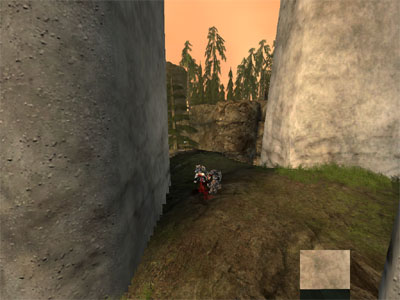Review - Xabre 600 Pro by PowerColor
Review by James on 04.30.2003
Analysis:
These results are actually quite interesting. At a low quality setting, the UT2K3 benchmark shows that the GeForce card is pulling ahead. Yet when as we move up in quality, the Xabre is barely phased compared to the GeForce which sees a DRAMATIC drop in FPS. I suspect this is a result, at least partly, of the Vertexilizer engine. Presumably, the card noticed it was getting enough throughput and did not worry about maximizing the FPS in preparation for unexpected heavy loads. Hopefully a driver improvement will tell the card to put out a little more at the lower levels, as the minimum FPS drops too low for a gamer's tastes.
Now, getting back to the point about how the numbers do not tell all. The quality of the GeForce graphics, though running faster, was quite poor. Like we see in the picture below, the GeForce fairly frequently produced artifacts and was subject to much pixelation. In almost all of the test performed, some kind of rendering problem was noticable. The quality of the image with the Xabre was much more consistent. In fact, while playing UT2K3 and watching the tests run, I did not see any artifacts or pixelations whatsoever, just slow-downs. The higher 3DMark points received by the Xabre card, because 3DMark has the ability to calculate image quality, are probably a good summation of what we see more visually running the UT2K3 tests, where the graphical errors really show themselves.
However in the ChameleonMark scores, the Xabre falls apart. The GeForce produces a great video much faster. At first, I thought it may have been a setting I had slipped up on, but after tweaking for sometime and then going back to the default, I did not get any higher scores. I wouldn't rely on this test TOO much, however, because it is designed to test NVidia cards. Nonetheless, the pixel shaders are obviously behind in the Xabre card as indicated by both the 3DMark Scores in this area and the ChameleonMark. The Comanche Benchmark also indicates a performance slip for the Xabre. If you enjoy your flight simulators, the Xabre is not for you.

Conclusion:
The gaming experience, overall, was better with the Xabre card. However, it can by no means be considered a next-generation card despite being the first to use the 0.13u process. It is exactly what SiS labeled it: a high-end mainstream card. It will be a great card for DirectX 8.1. However, with DirectX 9 out and coming to be supported by more mainstream cards in the next 6 months or so, this card is definitely on its way to becoming outdated before its release date.
If you are expecting to run any apps that required pixel shading, stay far away from this card. Some unmentioned advantages of the card were the ease of use of the S-Video out functionality. As mentioned earlier, the card came with an S-video out cable that converts to RCA component Video and a lengthy RCA cable to connect to a TV. The NVidia does not support the RCA standard and the S-Video signal would not work with the RCA adaptor (Chaintech only came with an S-Video-to-S-Video cable). On the other hand, the Xabre card worked seamlessly with the TV, allowing easy play of videos in a range of formats on my TV.. The system tray utility was a breeze to setup.
A little bit of prior knowledge is required. For example, you would have to know that U.S. televisions use the NTSC standard, not PAL which is the default setting (does SiS expect more European sells than American?). The manual is certainly lacking in explaining how to set it up. In fact the only instructions it does give on the subject were erroneous. They say to put the TV out as the secondary ouput, but if you are trying to watch a DVD or other video from your TV, you must set the TV to be the primary output, otherwise you get a blank screen where the video should be. Also, the manual said not to plug the cable in with the computer or TV on, but I did not have any problems with the computer turned on.
At approximately $80, the Xabre card is not to be overlooked for the very casual gamer. However, it is certainly not the next-generation card SiS wanted us to believe it was 8 months ago nor is it on the line between the enthusiast and mainstream markets: It is firmly in the middle of a diverse mainstream gaming-card market. In the end, if you are the type of person to check out reviews for computer hardware, you are not likely in the target market of this card. However, maybe everyone can begin to recover their missing PCI slots now that market forces are pushing chipmakers to 0.13u GPU's.
| « Other Benchmarks | More Reviews » |

